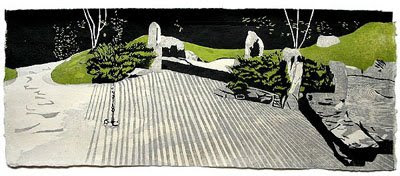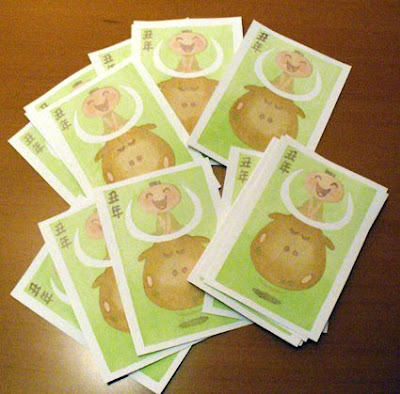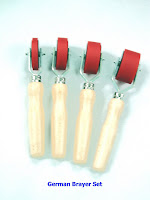Today's postings
- [Baren 38085] Re: Fair Use Or Infringement? (Annie Bissett)
- [Baren 38086] thanks for the ideas (Rosposfe # aol.com)
- [Baren 38087] Moku Hanga Paper Question (Annie Bissett)
- [Baren 38088] Re: Moku Hanga Paper Question (Barbara Mason)
- [Baren 38089] Baren Member blogs: Update Notification (Blog Manager)

Message 1
From: Annie Bissett
Date: Fri, 06 Feb 2009 19:03:41 GMT
Subject: [Baren 38085] Re: Fair Use Or Infringement?
Send Message: To this poster
Fairey has made a career of using pre-existing images in his prints,
but this one has gotten so famous that it's finally drawn his
methodology into question. I've been following it closely, as many of
us illustrators use photo reference for our work, especially
portraiture. The "safe" way to go about it is to purchase rights or
get permission to use photo references. Also, if it's a famous person
or event, the "fair use" argument usually comes into play -- that the
image is newsworthy and therefore can be referenced for comment
without being considered an infringement.
What the NPR story doesn't mention is that the photographer who took
the Obama photo that Fairey referenced (Manny Garcia) said not only
that he doesn't care that it was used as reference but that he DIDN'T
RECOGNIZE IT AS HIS OWN PHOTO when he first saw the poster. This
suggests that Fairey changed it enough that this case wouldn't hold
up as an infringement in a court of law. This is what really galls
me, that it's not the photographer that's complaining but the
Associated Press. Copyright law has morphed into a set of regulations
that don't really protect individual creators but corporate entities
(like Disney, Getty Images, AP, big publishers). A photographer like
Manny Garcia has to sell his work, including copyrights, for a
pittance to big distributors like AP in order to make it to the
market - he gets no protection at all.
If you can't tell, I come down firmly on the side of Shepard Fairey!
http://www.npr.org/templates/story/story.php?storyId=100301384
best to all,
Annie B

Message 2
From: Rosposfe # aol.com
Date: Sat, 07 Feb 2009 03:28:56 GMT
Subject: [Baren 38086] thanks for the ideas
Send Message: To this poster
Thank you for all the ideas for my printing project with the third
graders. I am once again awed at the power of the internet to link me to all of
you and to be able to so easily access the collective years of experience across
continents and cultures. I am digesting all the ideas and collective
experiences to figure out what will work out best for them(Me) but will file all the
others to the "future projects" section of my brain--some of them will be
trialed with my two children at home.
I've never worked with brayers/roll out inks and am reluctant to have to buy
them so I'll try to figure out how to use my brushes and barens.
They are about to start a "learning about birds" section and I suspect I
will do a kind of "raffle" where each child picks out a bird body part (eye,
beak, feather, talon, foot, etc) and I'll have them draw them out either on
paper which we will then collage all together (and use as a Hanshita) or directly
on smallish blocks of Shina. We'll then put them all together in a rough,
Picasso-esque, way and print all together with Sumi in black and white, each
kid getting to pull a print of the whole shebang. I have a nice ball-bearing
baren and it's relatively easy to pull a decent print if the paper is thin
enough. I figure if I have them draw with medium markers I'll keep the detail to a
doable level and leave the carving to me (we have two-months!) and the
drawing/collage assembly and printing with the kids.
So, I think this is where we're going, I'll keep you posted and post
pictures and updates as we move along.
Thanks,
Andrew.
P.S. I just received my box of Hosho paper from McClains so printing on my
Year of the Ox cards will begin this weekend!
Those who can't wait or aren't participating this year can see the proof (on
Rives BFK) on my blog:
rospobio.blogspot.com

Message 3
From: Annie Bissett
Date: Sat, 07 Feb 2009 03:34:24 GMT
Subject: [Baren 38087] Moku Hanga Paper Question
Send Message: To this poster
I'm participating in a print exchange and the paper that has been
selected for use is Rives BFK heavyweight. I've used Rives
Heavyweight (not BFK heavyweight) and had success, but I have a
feeling that the BFK might be too thick for the moku hanga technique.
(I'm the only participant who works with the Japanese method.) Have
any of you hanga folks tried BFK?
Thanks much,
Annie

Message 4
From: Barbara Mason
Date: Sat, 07 Feb 2009 12:21:21 GMT
Subject: [Baren 38088] Re: Moku Hanga Paper Question
Send Message: To this poster
my best
Barbara
Digest Appendix
Postings made on [Baren] members' blogs
over the past 24 hours ...
Subject: Eva Pietzcker at Cullom Gallery
Posted by: Annie B
 Cullom Gallery in Seattle is showing the work of Berlin-based artist Eva Pietzcker, a woodblock artist whose work I have admired since I discovered it several years ago through the Baren Forum. Eighteen of Eva's large, bold moku hanga landscape prints will be on display at Cullom through March. If you aren't near Seattle, you can see all the prints on the Cullom Gallery web site. Also in Seattle this weekend at Davidson and Cullom Galleries is the Seattle Print Fair. I wish I lived closer to the Pacific northwest! |
This item is taken from the blog Woodblock Dreams.
'Reply' to Baren about this item.
Subject: EXECUTIVE DIRECTOR JOB SEARCH
Posted by: Dean Clark
This item is taken from the blog Printmakingblog.
'Reply' to Baren about this item.
Subject:
Posted by: Diane Cutter
 After two months of travel, I'm back home in my studio. I expect these deer will find themselves the subject of a woodcut. We spied them along the dusty road in the Bosque de Apache National Wildlife Refuge, just 20 miles south of Socorro, New Mexico. It's a haven for migrating birds, northern visitors seeking warmer winter climes. The best time to visit is sunrise and sunset for the 'fly out' and 'fly in' of the birds. Of course, we were there around noon so saw few birds (cranes, geese) but we did catch these shy deer cautiously watching me approach with my camera. ~~~~~~~~~~~~~~~~~~~ Despues de dos meses de viaje, estoy de nuevo en mi estudio. Espero que estes ciervos sean models para un grabado de madera. Los habiamos espiado al lado del camino polvoriento en el Bosque de Apache National Wildlife Refuge (parque nacional) a solo 32 kilometros al sur de Socorro, Nuevo Mexico. Es un refugio para aves migrando para el invierno del norte lejano al clima mas templado. El mejor tiempo para visitar es el amanecer y el atardecer para el vuelo en masa de los parajos. Claro... estuvimos alla al mediodia entonces vimos pocos aves (garzas, gansos) pero si espiabamos estes ciervos timidos vigilandome acercandoles con mi camera.
|
This item is taken from the blog The Itinerant Artist.
'Reply' to Baren about this item.
Subject: Top Hat (relief etching on zinc)
Posted by: Viza Arlington
This item is taken from the blog VIZArt.
'Reply' to Baren about this item.
Subject: Sembrar es una forma de Resistencia
Posted by: alynn
|
This is the title of my last exhibit at Fountain St. Church. The work has to do with seeds; the importance of saving, planting, and sharing them, also it the first time in many years that I make colorful and hopeful art, there is no satire or hidden messages this time.
[This was a summary of the original entry. The full entry can be viewed here] |
This item is taken from the blog Alynn Guerra.
'Reply' to Baren about this item.
Subject: Year of the Ox Prints
Posted by: Mark Mason
 I finished my Year of the Ox woodblock Postcard prints a couple of weeks ago, and here they are. The finished edition size is about 25. My previous post on the design of the Ox postcard is HERE. I overprinted the green background with a bokashi graduation effect from the bottom of the print, and a second doughnut shaped bokashi effect on the ox.  When my wife, Sally, saw the finished print for the first time she said it looked like a baby on a space hopper. Job done. The prints were made using Hydrus Pigment Watercolours and printed onto blank Japanese postcards. |
This item is taken from the blog Curiously Drawn.
'Reply' to Baren about this item.
Subject: La Chianina
Posted by: Andrew Stone
 One of the most ancient breeds of cattle still alive is the Chianina. It had been depicted on Roman sarcophagi and ancient painted scrolls from antiquity. It is an enormous beast, easily surpassing 2200lbs live weight and was the beast of burden of choice for the ancient Romans as well as for the prudent contadini (peasants) for its rustic and thrifty nature. It is a beautiful pure white color with black mucous membranes and horns that are black when young and lighten on ageing. When the tractor began to replace animal traction in the 1950's it survived due to it's popularity as a source of meat and the Florentine beefsteak still eaten in trattoria all over Italy usually comes from this breed raised in the region of Maremma in southern Tuscany. It has been imported all over the world and in the USA, in the Northeast where small pockets of stubborn small farmers keep working the land via animal power the Chianina can also be found harnessed to the plow and cart. 2009 is the Year of the Ox according to the Chinese Zodiac and out of respect for the thousands of years that this beast has worked the fields of Italy and abroad he/she is the subject of my annual, . . . [Long item has been trimmed at this point. The full blog entry can be viewed here] |
This item is taken from the blog Lacrime di Rospo.
'Reply' to Baren about this item.

